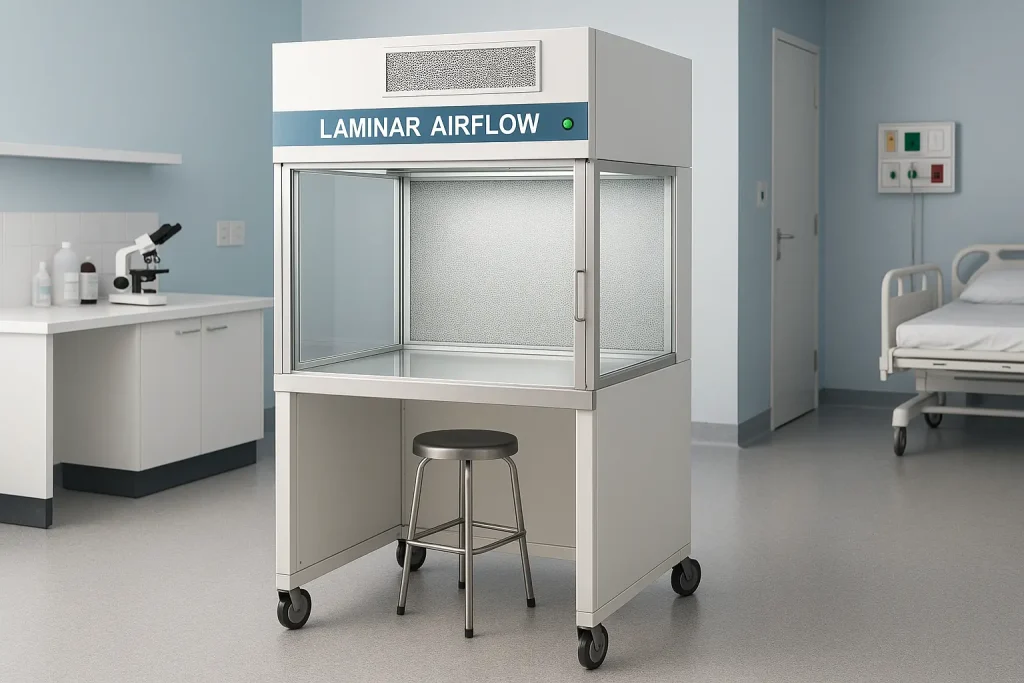
Enhanced Sterility and Contamination Control
Mobile laminar airflow units instantly create a sterile zone. They filter out harmful airborne particles using HEPA filters, protecting sensitive samples and instruments from contamination. Hospitals rely on them during surgeries and emergency procedures, and labs use them when handling sterile media or cultures.
Portability for On-Demand Clean Environments
Unlike fixed clean rooms, mobile laminar flow units offer unmatched mobility. You can easily move them between different departments or lab sections. This flexibility makes them ideal for emergency contamination control. It also reduces the need for multiple permanent setups. As a result, institutions save on infrastructure costs.
Improved Safety for Personnel and Patients
These units offer strong protection for both patients and professionals. Hospitals reduce infection risks through high-touch procedures. In laboratories, they protect workers from exposure to airborne toxins and contaminants. The clean airflow acts as a barrier between the user and harmful agents.
Cost-Effective Alternative to Permanent Installations
Installing traditional cleanrooms is expensive. Mobile laminar airflow units provide a budget-friendly alternative. They deliver cleanroom-grade protection at a fraction of the cost. Maintenance is simpler and cheaper. Their reusability and long lifespan increase ROI significantly.
Fast Deployment in Critical Situations
Time is critical during outbreaks or emergencies. Mobile laminar units are plug-and-play systems that can be activated immediately to contain and control infection zones. Hospitals often use them during sudden surges in patient admissions, and labs deploy them when handling sensitive experiments under time pressure.
Supports Compliance with Hygiene Standards
Maintaining sterile conditions is essential for regulatory compliance. These units help institutions meet ISO and GMP requirements. By offering reliable air filtration, they reduce audit risks. Their documentation and validation features support compliance reporting easily.
Versatility Across Medical and Scientific Settings
These airflow units are used in various fields. Hospitals, pharmaceutical labs, and research centres benefit from their use. They are ideal for IV preparation, cell culture work, and post-op care. Their compact design fits well in tight spaces without sacrificing performance.
Energy Efficient with Low Operating Costs
Modern units are built with energy-saving features. They consume less power than full-scale HVAC systems. Their efficient motors and low noise levels add comfort to the work environment. Operating them continuously doesn’t lead to skyrocketing bills.
Ease of Maintenance and Cleaning
Cleaning these units is simple and quick. Most are built with smooth stainless steel surfaces. They resist microbial growth and can be disinfected rapidly. Their design ensures that no contaminants build up inside over time. Maintenance schedules are minimal and easy to follow.
Promotes Consistent Research and Treatment Results
Contamination can ruin experiments and jeopardize patient care. Mobile laminar units ensure consistent sterile conditions. This consistency improves the accuracy of lab results and enhances treatment outcomes. In high-risk environments, reliability matters—and these units deliver.
Conclusion
Mobile laminar airflow units are essential for modern labs and hospitals. Their portability, efficiency, and reliability offer countless benefits. They reduce costs, enhance safety, and ensure compliance. Whether in critical care or advanced research, these units provide vital support.